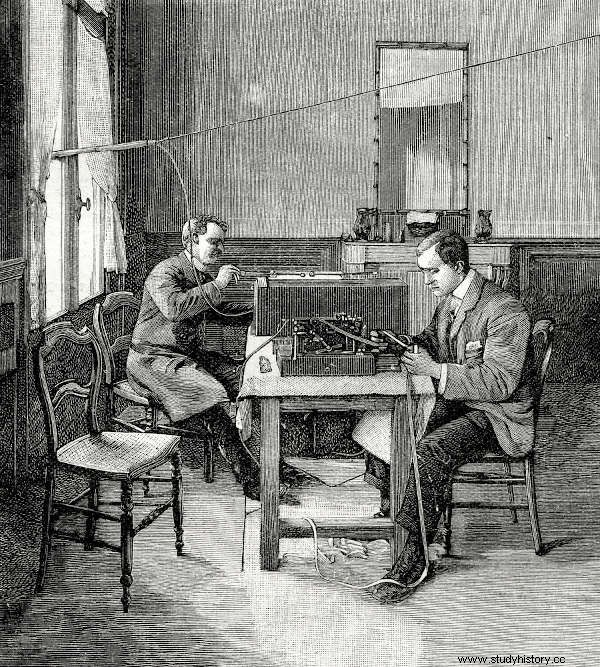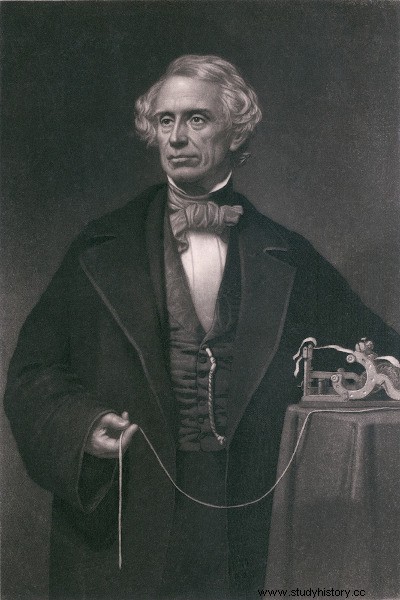
The telegraph is a communication device that was invented by Samuel Morse in 1837. This device used electric current to send codes that were interpreted by the telegraphy agent. Messages were sent in a code that was also invented by Samuel Morse and called Morse Code.
The first commercial telegraph line opened in 1844, connecting Washington to Baltimore , in the United States. Soon telegraphy became the main means of communication on the planet, being used on all continents. In Brazil, the telegraph arrived in 1852, being installed by decision of Emperor d. Pedro II.
Read more: The invention of printing — occurred in the 15th century by Johannes Gutenberg
Telegraph Summary
-
The electric telegraph was invented by Samuel Morse in 1837.
-
It used electrical energy to send pulses in the encoded current and a code also created by Morse.
-
The first commercial telegraph line from Washington to Baltimore opened in 1844.
-
Brazil's first telegraphy line was installed in Rio de Janeiro in 1852.
-
The first existing telegraph was not electric, but semaphore, created in 1792 in France.
What is the telegraph and why is it important
The telegraph was one of the most important inventions of the 19th century , being a demonstration of the great technological development that happened during this century. It was a device used in long-distance communication, allowing encrypted messages to be sent immediately to other locations.
The device was also known as an electric telegraph because it used electrical energy . It sent the coded message signals through electrical pulses, which traveled through the electrical current and were sent to another telegraph station, where the message would be recorded.
The fact that the telegraph uses electrical energy made it necessary to extend networks of electrical wires to make communication possible. Initially the cables were suspended in the air by means of wooden poles, but over time, underground cables and marine cables were developed.
The electric telegraph was invented by Samuel Morse , an American painter and professor, and the first commercial telegraph line went into operation in 1844. The telegraph invented by Morse had a small recorder that printed the message received at the time on paper.
He was also responsible for creating the code used in telegraph communications, the well-known C Morse code . The popularization of the telegraph made it spread across all continents of the planet and allowed intercontinental communication. Here, the first telegraph was installed in the 1850s.
Read more: The invention of television — the interest in creating the device was already found in the 19th century
How the telegraph came about
The telegraph was the result of the need to establish faster means of communication in the 19th century. It was only possible thanks to a series of advances in existing knowledge about electricity, but also thanks to a series of failed attempts.
Before the emergence of the electric telegraph, the traffic telegraph had been invented in Europe , in which communication was carried out through signs that brought coded messages. This telegraph was invented by Claude Chappe in 1792 and was very popular in Europe until its electric version appeared.
The semaphore telegraph worked as follows :towers were built in strategic positions (higher positions), and on top of them were placed posts used to support panels that received coded messages. Communication took place with the transmission of this message from one tower to the other.
So, in each tower there was a person responsible for the panels and whose function was to observe the previous tower to identify if any messages had been placed. If so, it transmitted the message on its tower panels so that the operator of the next tower could see it and also transmit it.
This system had an archaic and limited functioning , did not work at night or when there was fog. However, it was quite efficient and could cover hundreds of kilometers in about 15 minutes.
-
How the electric telegraph came about

The invention of the electric telegraph was only possible thanks to huge advances in knowledge about electricity . Attempts to develop it had been going on since the mid-eighteenth century, but they always ran into a lack of practicality.
This made the machines difficult to manufacture and made their maintenance very complex, which made their commercialization unfeasible. One such model was developed by Carl Friederich Gauss and Wilhelm Weber , and in it a galvanometer (a low-intensity electrical current meter) made a needle go right or left.
This movement indicated letters that were deciphered by means of a binary code, but the telegraph produced by them in 1833 and the binary code used did not become commercially popular. Shortly thereafter, in 1837, Samuel Morse accomplished the feat of manufacturing an electrical telegraph with a code of signals that used pulses of electrical current.
Both the device and the code he created became popular, and in 1842 he received authorization from the US Congress to build the first telegraphy line in the United States. The line would link Washington to Baltimore and was 40 miles long. It was inaugurated in 1844, and the first message was sent by Samuel Morse himself.
In 1861, the first line crossing the United States from east to west was completed and connected San Francisco, California, to the East Coast. In 1866, the first intercontinental line was installed and connected the United States to Europe. Throughout the 19th century and from part of XX, the telegraph was the main means of communication.
Read more: The Origin of the Book — A Path from Antiquity to the 19th Century
When the telegraph arrived in Brazil
The telegraph arrived in Brazil in 1850 , being installed more precisely in 1852, in the city of Rio de Janeiro . The first Brazilian telegraphy line was built at the request of Emperor d. Peter II. It was installed in Rio de Janeiro, connecting Quinta da Boa Vista to Campo de Santana, with an extension of 4300 meters.
In the 1870s, Brazil was connected to Cape Verde and Portugal by means of a submarine telegraphy line. This line also connected Pará to the province of Pernambuco. The telegraph expanded rapidly throughout Brazil, and, about 20 years after arriving here, there were already 182 stations linking different parts of the country.
